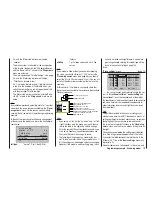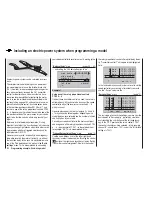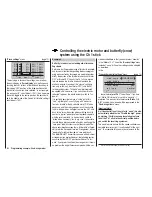
159
Programming example: delta and fl ying wing
Programming a model delta using the “normal” tail
setting
Alternatively, if you select the “
normal
” tail type in the
“
Basic settings
” menu, and connect the servos to the
receiver as shown in the lower of the two receiver socket
sequence diagrams on the left-hand page, then the
aileron function of the two elevon servos will work cor-
rectly, but not the elevator function.
In the “
normal
” tail type you have to force the two ailer-
on servos and the two fl ap servos to move in the same
direction and provide an elevator effect when an eleva-
tor command is given. This requires the “
elev
¼
NN
*”
wing mixers, whose effect can be adjusted separately.
The procedure starts by selecting the …
“Fixed-wing mixers”
menu
(pages 88 … 93)
(The following settings are model-specifi c, and you
must check carefully that they work correctly on
your model before accepting them.)
0%
0%
0%
+55%
0%
+55%
+66%
+77%
+77%
0%
0%
0%
–––
–––
–––
–––
–––
–––
–––
–––
–––
–––
–––
a i l
a i l
d i f f a i l e .
rudd
flaps
brak
brak
brak
elev
flap
aile
elev
elev
flap
flap
aile
elev
flap
d i f f – r e d
aile
d i f f f l a p s
… where you set values other than zero for these mixers.
With this set-up the tailless model is considered to be a
Expo
” menu (see page 82).
If you select “
Delta / fl ying wing
”, all settings of the
“
NN
*
¼
elev
” wing mixers in the …
“Fixed-wing mixers”
menu
(pages 88 … 93)
0%
0%
0%
–––
–––
–––
0%
d i f f a i l e .
a i l
rudd
brak
elev
d i f f – r e d
… affect the elevator (up / down) function of the two
elevon (combined aileron / elevator) servos, as well as
the fl ap / elevator servos.
Notes:
The flap mixers and flap differential only appear in
•
the list if you have also entered “2fl” in the “aile/flap”
line at the “Delta / Flying wing” model type; see illus-
tration on the right.
In principle the same applies to the “Brake
•
¼
NN *”
mixers. These are also suppressed if you have de-
cided on “Throttle min forward / back” in the “motor at
C1” line of the “
Basic settings
” menu.
Even if you have selected “2aile2fl”, the (digital) ele-
•
vator and aileron trims only affect aileron / elevator. If
you wish to circumvent this, it is simpler to program
your model as described in the following section.
“normal” four-fl ap wing (two ailerons and two fl aps), and
therefore has all the options associated with this wing
type. The method involves the “
elev
¼
NN *”
mixers,
which were originally intended only for pitch trim com-
pensation and non-standard applications. In this case
they are “abused” by setting higher values than normal,
in order to transfer the elevator signal to the control
surfaces of the tailless model.
However, none of the fi xed-wing mixers includes the
digital trim of the elevator stick - so an alternative has to
be found.
Start by switching to the …
“Transmitter control settings”
menu (page
74)
I5
I6
I7
+
tr v
+15%
+15%
+100% +100%
ctrl 6
I8
+100% +100%
free
free
ctrl 6
+15%
+15%
… and assign the
same
transmitter control to the inputs
5 and (if required) 6, e. g. the rotary proportional control
CTRL 6. Now move to the “Travel” column and reduce
the travel of the transmitter control for these two inputs
symmetrically to around 50%, or even less, because: the
lower this value, the fi ner the trim control.
However, if you prefer to use the normal elevator trim
lever, set - or leave - the “
elev
¼
NN
*” mixers to 0%,
and instead set up free linear mixers to do the job.
This is done by calling up the …
* NN = Nomen Nominandum (name to be stated)
Summary of Contents for mx-16 HOTT
Page 7: ...7 For your notes...
Page 37: ...37 For your notes...
Page 41: ...41 For your notes...
Page 45: ...45 For your notes...
Page 51: ...51 For your notes...
Page 55: ...55 For your notes...
Page 81: ...81 For your notes...
Page 103: ...103 For your notes...
Page 133: ...133 For your notes...
Page 141: ...141 For your notes...
Page 161: ...161 For your notes...
Page 173: ...173 For your notes...
















































